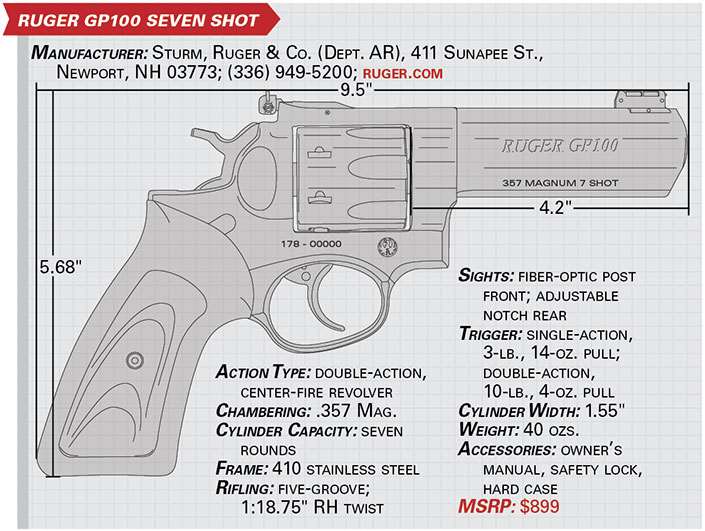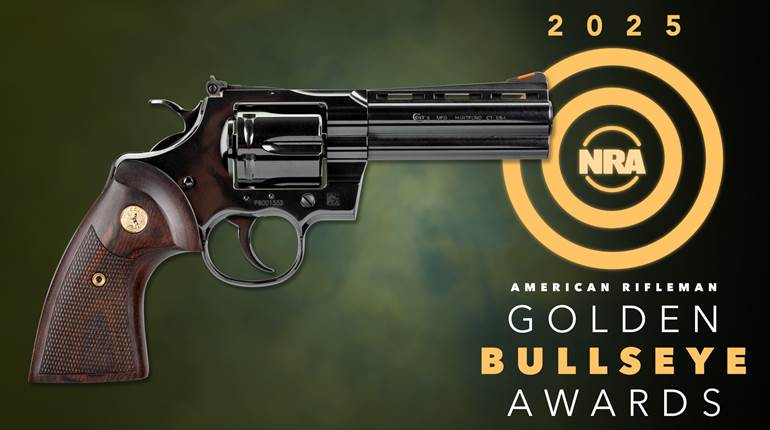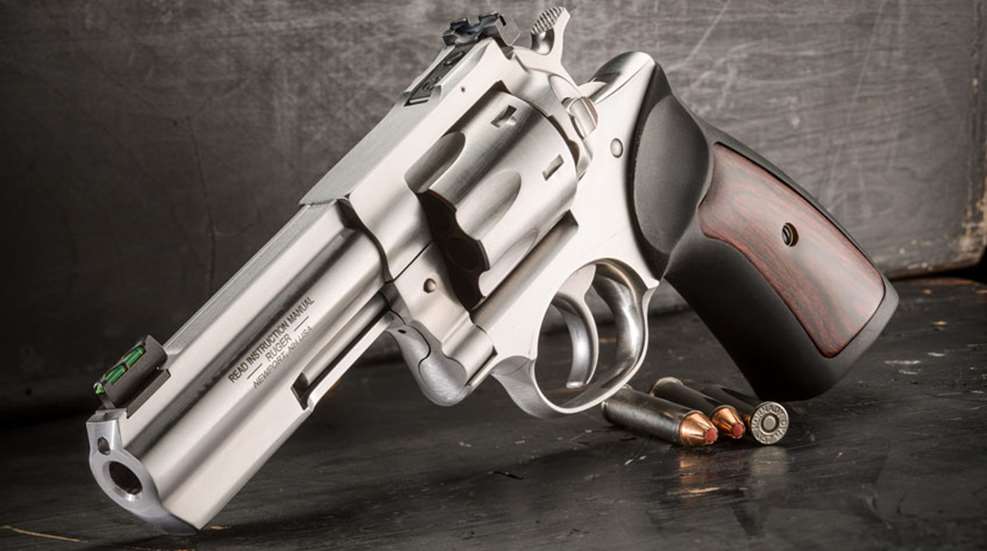
In selecting a handgun for protection, oftentimes double-action revolvers are dismissed as choices due only to their limited capacity. But that has changed somewhat, as viable, familiar wheelgun platforms have, of late, been updated with increased-capacity cylinders. The double-action GP100 is a fine example—previously only available in .357 Mag. with six-shot cylinders—Ruger is now offering a seven-shot version of the reliable revolver. The .357 Mag. GP100 seven-shot, the subject of this review, has a round count rivaling some small semi-automatic pistols, yet offers far superior stopping power.
Increasing the revolver’s capacity by one round wasn’t a complicated task. Essentially, the spacing between the chambers of the fluted, 1.55"-diameter cylinder was decreased to accommodate a seventh one, and the placement and timing of attendant cylinder latch lockup points needed to be adjusted. Since the revolver was designed (if not overbuilt) from the outset for a steady diet of heavy, .357 Mag. ammunition, no further changes to the gun were needed.
The GP100’s triple-locking cylinder/crane assembly is secured to the heavy, investment-cast frame at the front, bottom and rear. Beyond enhancing durability, this aids forcing cone/chamber alignment (timing) to minimize bullet shaving and improve accuracy. The ejector rod doesn’t rotate with the cylinder, rather, it merely serves as an ejector.
Expedited cleaning is possible due to the revolver being able to be quickly and easily disassembled into sub-assemblies, such as the cylinder/crane, hammer and trigger guard assemblies. With the exception of a screwdriver, no other tools are needed to accomplish this. Pressing inward on the oversize crane latch—on the left, rear side—grants access to the left-swinging cylinder for loading and unloading.
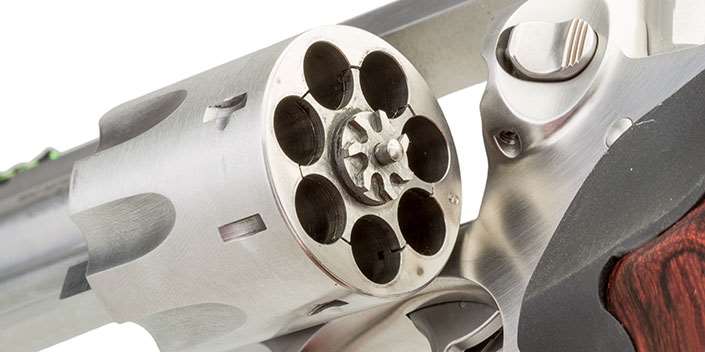
The frame is machined from a 410 stainless steel casting. To increase strength, there’s no sideplate; instead, the internal parts are installed either through the top or bottom of the grip frame. Contributing to the test revolver’s 40-oz. weight and front-heavy feel is a 3/4"-thick, 4.2" barrel. Also available are 2.5"- and 6"-barreled versions weighing 36 ozs. and 43.5 ozs., respectively. While somewhat taxing for everyday, all-day carry, the heft greatly reduces the perceived recoil of stout .357 Mag. loads. Of course, in addition to .357 Mag. ammunition, the gun can safely fire .38 Spl. +P and .38 Spl. loads as well.
Topping the barrel is a fiber-optic post front sight with a green pipette, while the blade rear sight is secured to a cutout in the topstrap. Adjustable for windage and elevation, the rear’s 0.140"-wide notch is outlined in white to increase visibility in compromised lighting. Each click is valued at 3/4" at 25 yds. The barrel has 1:18.75" right-hand-twist rifling, and ends with a recessed crown to protect the rifling—a welcome feature for a gun that is likely be holstered and carried a lot.
The GP100’s frame extension permits the use of full wrap-around-type stocks that are easily exchanged with aftermarket models if so desired. From the factory, the handgun wears a cushioned, slightly tacky rubber stock with hardwood inserts that is both functional and aesthetically pleasing. A recessed portion of the top, left side permits the right-handed shooter’s thumb to rest closer to the frame and point the gun more naturally. Moreover, it improves access to the crane latch.
As a double-action revolver, the GP100 can be fired in single- or double-action modes. Thanks to a lengthy hammer spur with aggressive checkering, cocking the hammer isn’t an arduous task, and the trigger pull on the sample was 3 lbs., 14 ozs. There was minimal creep and overtravel, too—overall an excellent trigger. In double-action mode, though, the trigger pull measured 10 lbs., 4 ozs. Taking a well-aimed shot through the double-action pull would take a concerted effort. The revolver has no user-set safety; instead, it has a transfer-bar mechanism that prevents the handgun from discharging unless the trigger is purposefully pulled fully to the rear.
Testing of the sample GP100 began with shooting five consecutive, five-shot groups from a sandbag rest at 25 yds. using three, diverse .357 Mag. loads. They included: Federal Premium Vital-Shok 180-gr. CastCore; Federal Premium Personal Defense 158-gr. Hydra-Shok jacketed hollow point; and PMC Gold 150-gr. Starfire Hollow Point. Of the loads, the most accurate proved to be the latter, averaging 1.73" for all 25 shots. Although notably larger than the defensive offerings, the 2.56" average of the 180-gr. CastCore load would suffice for close-range feral hog and deer hunting, or defense in the backcountry.
With accuracy testing completed, we then chronographed the loads; most loads were close in velocity to their factory numbers. The exception was the PMC ammunition; according to the Competition Electronics ProChrono Digital chronograph, it averaged 1094 f.p.s., while factory-published speeds are touted as being 1350 f.p.s. In the hands, these loads seemed exceedingly mild, too, confirming the chronograph’s reading.
Rapid firing on a variety of reactive and stationary targets with low-recoil Federal Gold Medal Match 148-gr., .38 Spl. lead wadcutter match ammunition was pure pleasure. Such is the benefit of a revolver chambered in .357 Mag.—building confidence and muscle memory with reduced-power loads without the recoil, but having power if needed. Multiple shooters who held or shot the revolver commented positively about its feel. The muzzle-heavy characteristic helped reduce muzzle flip and aided pointing. While the heavy, double-action trigger was tough to use for pinpoint bullet placement, when shooting rapidly it wasn’t a problem. Delivery of rounds on multiple targets was quick, and there were no malfunctions whatsoever.
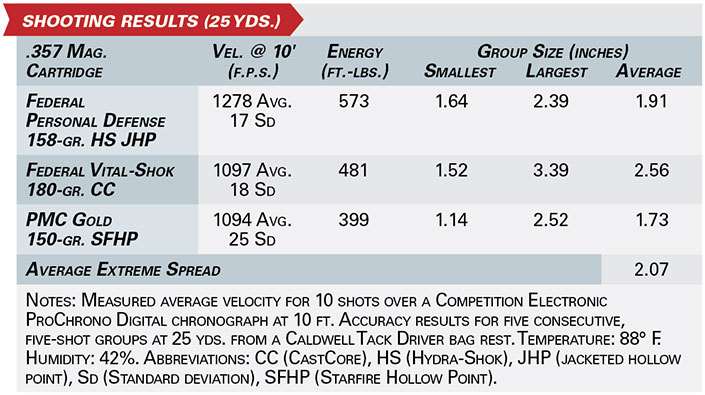
There are a few changes that we’d suggest. First, it would be nice for the topstrap to be drilled and tapped for scope bases for hunting or feature Ruger’s optic-mounting system. There are, however, excellent aftermarket designs, such as those by Weigand, that can be added without altering the gun. Secondly, whereas the sides of the frame and the trigger guard assembly melded together seamlessly, there was a minute gap between the two on the bottom of the revolver. It didn’t affect performance or reliability, though.
In any of its various standard configurations, the GP100 would be a fine choice for home defense, protection on the trail, hunting feral hogs and deer-size game, or plinking (especially with low-cost and light-recoiling .38 Spl. ammunition). The fact that it now carries a seventh round just makes it all that much better.
